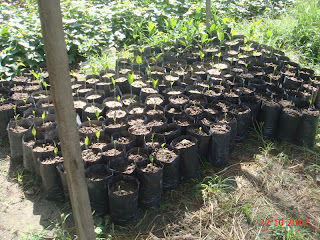 |
| The 3rd batch 1st planting. The 3 Mas Solo, with fruits awaiting ripening. |
2nd planting was close to our pond. The clay soil here is very hard and being a bulldozed ground, there were no top soil. We had quite a number of plants dying off, due to the drought. Some were replaced many times yet still not successful. There are only about 15 trees here, and of various stage of growth. I find that this the most challenging area as the ground and weather was at it most unfavorable condition. Even though it was close to the pond, the pond dried up during drought season.
3rd planting was at the most fertile ground, and close to the creek. Unfortunately as with the pond, it dried during drought. We have about 20 trees here and all of them are waiting to ripe. The trees have quite some fruits, but unfortunately due to the drought, quite a numbers are irregularly shaped and not fully developed. We shall most probably sell these off as green papaya or use the fruits for seeds. Most of the trees here are Mas Solo.
4th planting was done, inter-cropping with pumpkins. We had initial watering problem and many died during the drought. Here we ran into weeding management as there were pumpkins too. With the pumpkin harvested and out of the way, things got simpler. We did plenty replanting. This area is the largest and were split into 2 part, lower and upper. The lower section were planted first. The variety here are mostly from our local mother tree, and some maybe even Kampung variety. We may have up to about 200 trees here.
5th planting was done along the access road, just behind the row of Berangan banana. Again due to the drought, there were plenty replacement. Some of the trees here are Mas solo. After this planting, we continued to plant here and there, where we find any idle land, or land that is not fertile. As papaya can withstand 'hot' fertilizer. We use lots of chicken dungs on our papayas. We had also transferred close to 300 papayas into Parcel 1. Lately most of these are for replacement.
We had stopped propagating papayas at the moment as we had lots of unhealthy seedlings lately. Not sure if it's due to the seed source or nursery bed. Another reason is that we are waiting for the Mas Solo to ripe and propagate them. We hope the Mas Solo taste sweet and is accepted by the market. We hope that the fruits shall ripe soon, germinate and transplant just before the the dry season.
 |
| Powdery mildew. |
Checked with the agriculture department the other day as they were running an incentive scheme for fruits & vegetable. Unfortunately we do not qualify. Looks like we shall have to do it on our own.
The initial 30 plants, the productivity has dropped and we has lesser harvest. We are getting lesser ripe fruits as we are harvesting green papayas too. Those that are irregularly shaped, we harvest it as green papaya. The pricing is only half the ripe papaya.
1 papaya tree were heavily infested by Powdery mildew. Had it washed down with fresh water, removing almost all of the Powdery mildew. Shall give it some fungicide soon.
 |
| Trunk of Mas Solo. |
Stay tune for more updates.
 |
| Trunk of the normal Papaya. |



















































